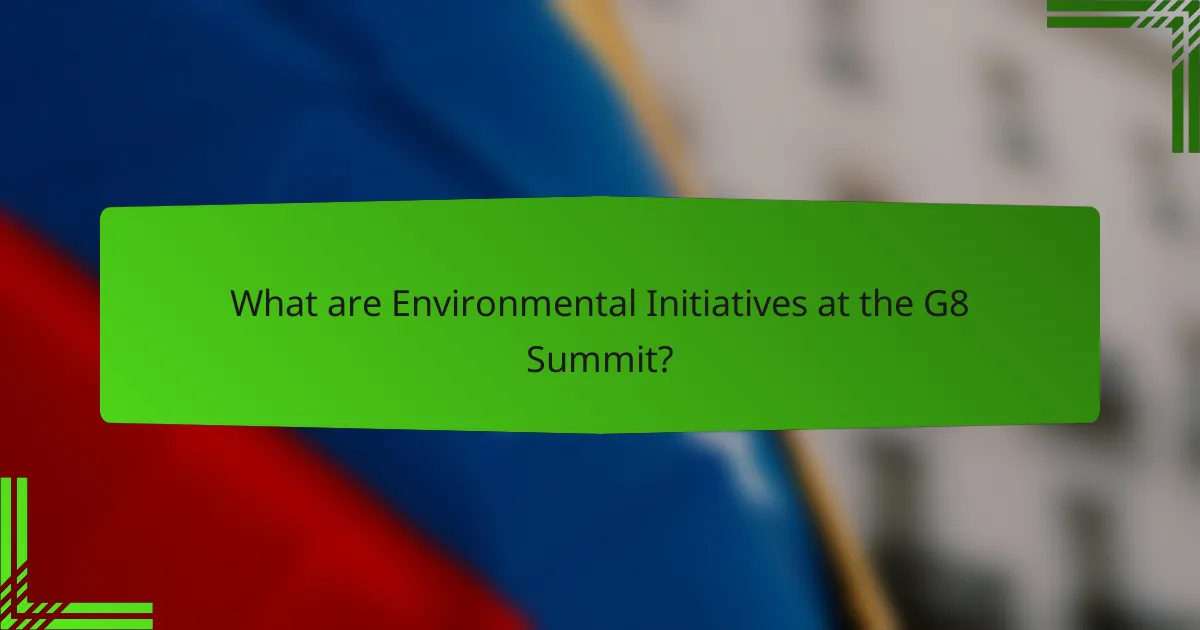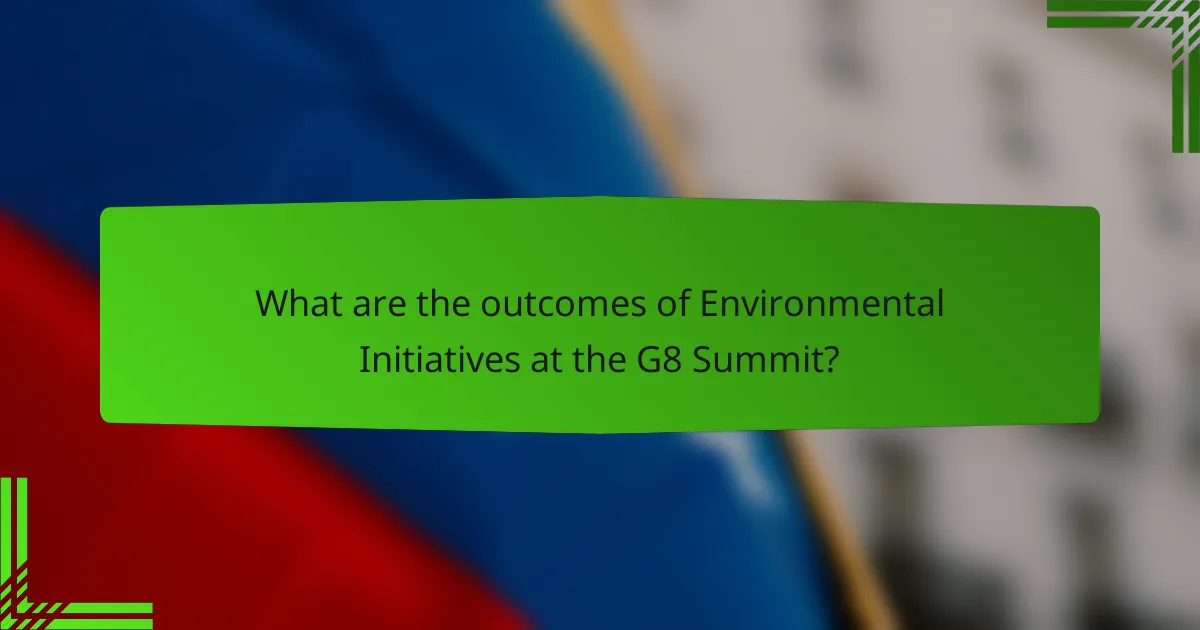The article focuses on environmental initiatives at the G8 Summit, which aim to combat climate change and promote sustainability among the world’s leading economies. Key efforts include commitments to reduce greenhouse gas emissions, limit global temperature increases to below 2 degrees Celsius, and emphasize the importance of renewable energy sources. The G8 nations also pledge financial support for developing countries and prioritize collaboration on technology transfer. Additionally, the article outlines the significance of sustainable agriculture and forest management practices, as well as the necessity for regular assessments to ensure accountability and progress in these initiatives.

What are Environmental Initiatives at the G8 Summit?
Environmental initiatives at the G8 Summit focus on addressing climate change and promoting sustainability. These initiatives include commitments to reduce greenhouse gas emissions. The G8 nations aim to limit global temperature increases to below 2 degrees Celsius. They also emphasize the importance of renewable energy sources. Initiatives often involve financial support for developing countries. Collaboration on technology transfer is a key aspect of these efforts. The G8 promotes sustainable agriculture and forest management practices. Regular assessments of progress are conducted to ensure accountability.
How do these initiatives address climate change?
These initiatives address climate change by promoting sustainable practices and reducing greenhouse gas emissions. They encourage the adoption of renewable energy sources like solar and wind power. Collaboration among G8 nations aims to share technology and strategies for climate resilience. Financial investments are directed towards clean energy projects and conservation efforts. Policies are established to limit deforestation and protect biodiversity. Education and awareness programs are implemented to engage communities in sustainability. The commitment to international agreements, such as the Paris Accord, reinforces collective action against climate change. These actions collectively contribute to global efforts in mitigating climate change impacts.
What specific climate change issues are targeted by these initiatives?
These initiatives target specific climate change issues such as greenhouse gas emissions, deforestation, and renewable energy adoption. They aim to reduce carbon footprints and enhance energy efficiency. Initiatives focus on transitioning to sustainable agriculture and protecting biodiversity. They also address climate resilience and adaptation strategies for vulnerable communities. The G8 Summit initiatives emphasize international cooperation to combat climate change impacts. Each targeted issue aligns with global climate agreements and scientific recommendations for limiting temperature rise.
How do these initiatives align with global climate agreements?
These initiatives align with global climate agreements by committing to emissions reduction targets. They support the goals outlined in the Paris Agreement, aiming to limit global warming to well below 2 degrees Celsius. The initiatives promote renewable energy adoption and energy efficiency, which are essential for achieving these targets. They also emphasize international cooperation, reflecting the collaborative spirit of climate agreements. Furthermore, they address climate adaptation strategies, aligning with the framework for resilience set by global accords. These actions contribute to a unified response to climate change, reinforcing commitments made by participating nations.
What sustainability efforts are promoted at the G8 Summit?
The G8 Summit promotes various sustainability efforts focused on climate change and environmental protection. Key initiatives include commitments to reduce greenhouse gas emissions. The summit emphasizes the importance of transitioning to renewable energy sources. It also encourages sustainable agricultural practices to ensure food security. The G8 leaders advocate for international cooperation on environmental issues. Furthermore, they support investment in green technologies. These efforts aim to foster a sustainable global economy. The G8 Summit serves as a platform for sharing best practices among member countries.
What types of sustainability practices are discussed?
Sustainability practices discussed include renewable energy adoption, waste reduction, and sustainable agriculture. Renewable energy practices focus on transitioning from fossil fuels to solar, wind, and hydroelectric power. Waste reduction strategies emphasize recycling, composting, and minimizing single-use plastics. Sustainable agriculture promotes organic farming, crop rotation, and water conservation techniques. These practices aim to mitigate climate change impacts and promote environmental health. The G8 Summit highlights these initiatives to encourage global cooperation in sustainability efforts.
How do these practices impact member countries’ policies?
Environmental initiatives at the G8 Summit significantly influence member countries’ policies. These practices encourage nations to adopt stricter environmental regulations. For instance, commitments made during the summit often lead to the implementation of renewable energy targets. Countries may also increase funding for sustainable development projects as a result. The G8’s collective stance on climate change prompts governments to align their policies with global standards. This alignment can result in enhanced international cooperation on environmental issues. Additionally, member countries may experience pressure from citizens to uphold these commitments. Historical data shows that post-summit policy changes often reflect the agreements reached during these meetings.

Why are Environmental Initiatives important at the G8 Summit?
Environmental initiatives are important at the G8 Summit because they address global climate change and sustainability. These initiatives foster international cooperation among the world’s leading economies. They aim to set binding agreements on emissions reductions. The G8 Summit provides a platform for discussing innovative solutions. It allows leaders to share best practices in environmental policy. Historical commitments, such as the 2005 Gleneagles Plan, illustrate the G8’s role in climate action. Collaborative efforts can mobilize resources for developing countries. Effective environmental initiatives can lead to significant reductions in greenhouse gas emissions.
What role do these initiatives play in international relations?
Environmental initiatives at the G8 Summit play a significant role in international relations by fostering cooperation among nations. These initiatives encourage collective action on climate change and sustainability. They create a platform for dialogue and negotiation among member countries. Such collaboration can lead to binding agreements and shared commitments. For instance, the G8 leaders have previously pledged to reduce greenhouse gas emissions. These commitments enhance trust and credibility among nations. Furthermore, successful initiatives can strengthen bilateral and multilateral relationships. They also influence global environmental policies and frameworks, such as the Paris Agreement. Overall, these initiatives are crucial for addressing transnational environmental challenges.
How do they foster cooperation among member nations?
They foster cooperation among member nations through collaborative agreements and joint initiatives. The G8 Summit facilitates discussions on environmental policies. These discussions lead to shared commitments on climate change and sustainability. Member nations exchange knowledge and best practices. They also coordinate funding for environmental projects. This approach enhances collective action against global challenges. Historical agreements, like the Kyoto Protocol, exemplify this cooperation. The G8’s focus on climate change promotes unity among nations in addressing environmental issues.
What are the potential consequences of inaction on these initiatives?
Inaction on environmental initiatives at the G8 Summit can lead to severe climate consequences. Rising global temperatures may exceed 1.5 degrees Celsius, resulting in extreme weather events. This can lead to increased flooding, droughts, and wildfires. Ecosystems may suffer irreversible damage, threatening biodiversity. Economic impacts can also be significant, with costs from natural disasters projected to reach trillions of dollars. Public health may decline due to air pollution and heat-related illnesses. Additionally, failure to act can undermine global cooperation on climate change, making future agreements more difficult. These consequences emphasize the urgent need for proactive measures.
How do Environmental Initiatives influence public perception?
Environmental initiatives significantly influence public perception by shaping attitudes towards sustainability. These initiatives often highlight the importance of environmental stewardship and responsible resource management. For instance, campaigns promoting renewable energy can increase public support for green technologies. Research shows that communities engaged in environmental programs report higher awareness of climate issues. A study by the Yale Program on Climate Change Communication found that 70% of Americans support renewable energy initiatives. This support translates into positive public perception of organizations leading these efforts. Furthermore, visible actions, such as clean-up drives or tree planting, foster community involvement and a sense of responsibility. Such initiatives can lead to a shift in social norms regarding environmental practices. Overall, environmental initiatives play a crucial role in informing and transforming public attitudes towards sustainability.
What impact do they have on citizen engagement and activism?
Environmental initiatives at the G8 Summit significantly enhance citizen engagement and activism. These initiatives raise awareness about climate change and sustainability issues. They mobilize communities to participate in discussions and actions. For example, the G8’s focus on environmental policies encourages grassroots movements. Citizens feel empowered to advocate for sustainable practices. Research shows that international summits increase public interest in environmental topics. A study by the Pew Research Center found that 70% of participants felt more motivated to engage after such events. This engagement leads to increased activism, as citizens demand accountability from leaders. Overall, G8 environmental initiatives foster a more active and informed citizenry.
How are these initiatives communicated to the public?
These initiatives are communicated to the public through various channels. Governments and organizations utilize press releases to announce new initiatives. They also conduct media briefings to provide detailed information. Social media platforms serve as a key tool for real-time updates and engagement. Public forums and community meetings allow for direct interaction with stakeholders. Educational campaigns raise awareness about environmental issues and initiatives. Reports and publications provide in-depth analysis and findings related to the initiatives. Collaborations with NGOs help amplify messages to broader audiences. These methods ensure transparency and encourage public participation in sustainability efforts.

What are the outcomes of Environmental Initiatives at the G8 Summit?
The outcomes of environmental initiatives at the G8 Summit include commitments to reduce greenhouse gas emissions. Leaders agreed to pursue policies that promote sustainable development. They emphasized the importance of clean energy technologies. The G8 also recognized the need for international cooperation on climate change. Specific targets for emission reductions were set for the coming decades. Financial support for developing countries was pledged to aid in environmental efforts. The initiatives aimed to foster innovation in renewable energy sources. These outcomes reflect a collective commitment to addressing climate change challenges.
What successes have been reported from past summits?
Past summits have reported significant successes in environmental initiatives. For instance, the G8 Summit in 2005 led to the Gleneagles Plan of Action. This plan committed member countries to increase aid for developing nations to combat climate change. Additionally, the 2007 Summit in Heiligendamm emphasized renewable energy and energy efficiency. It resulted in the establishment of the Global Energy Efficiency Action Plan. Furthermore, the 2010 Summit in Muskoka focused on sustainable development and pledged $5 billion for food security and nutrition. These actions demonstrate a collective commitment to addressing climate change and promoting sustainability.
How are these successes measured and evaluated?
Successes of environmental initiatives at the G8 Summit are measured through specific metrics and evaluations. These metrics include greenhouse gas emissions reductions, renewable energy adoption rates, and biodiversity preservation. Evaluation methods often involve monitoring compliance with commitments made during the summit. Reports from environmental organizations provide assessments of progress. Additionally, independent audits may be conducted to verify data accuracy. The effectiveness of initiatives is often analyzed through long-term environmental impact studies. These studies assess changes in ecosystem health and climate resilience. Regular updates and reviews help to track advancements and areas needing improvement.
What lessons can be learned from previous initiatives?
Previous initiatives demonstrate the importance of international collaboration in addressing climate change. Effective strategies often involve multi-stakeholder engagement, including governments, NGOs, and the private sector. Transparency and accountability are crucial for building trust and ensuring commitment. Setting measurable goals helps track progress and encourages ongoing participation. Public awareness campaigns can drive grassroots support and influence policy change. Historical examples, such as the Kyoto Protocol, highlight the challenges of implementation and the need for flexible frameworks. Adapting to local contexts improves the relevance and effectiveness of initiatives. Overall, learning from past efforts can enhance future environmental strategies.
What challenges do Environmental Initiatives face?
Environmental initiatives face several significant challenges. Funding is often insufficient to support ambitious projects. Many initiatives rely on government budgets, which can fluctuate. Public awareness and engagement are frequently low, hindering participation. Additionally, political will can be inconsistent, impacting long-term commitment. Regulatory frameworks may be inadequate or outdated, complicating implementation. Competing economic interests often prioritize short-term gains over environmental sustainability. Lastly, measuring the impact of initiatives can be complex, making it difficult to demonstrate success.
What are the common obstacles to effective implementation?
Common obstacles to effective implementation of environmental initiatives include insufficient funding, lack of political will, and inadequate stakeholder engagement. Insufficient funding limits the resources available for projects. Lack of political will often results in delayed actions and policy inconsistencies. Inadequate stakeholder engagement can lead to resistance and lack of support from communities and organizations. Additionally, complex regulatory frameworks can hinder quick decision-making. Poor communication among involved parties can further complicate efforts. These factors collectively contribute to challenges in achieving sustainability goals.
How do political and economic factors affect these initiatives?
Political and economic factors significantly influence environmental initiatives at the G8 Summit. Political will determines the commitment of member countries to pursue sustainable policies. Economic conditions affect the availability of funding for climate change projects. For instance, during economic downturns, governments may prioritize immediate economic recovery over long-term environmental goals. Conversely, strong economic growth can lead to increased investment in sustainability efforts. Additionally, international relations impact cooperation on joint environmental initiatives. Countries may align their policies based on diplomatic relations, affecting the overall effectiveness of the initiatives. Historical examples include the Kyoto Protocol negotiations, where political dynamics shaped commitments to emission reductions. Thus, the interplay of political and economic factors is crucial in shaping the success of environmental initiatives at the G8 Summit.
What can individuals do to support Environmental Initiatives?
Individuals can support environmental initiatives by adopting sustainable practices in their daily lives. They can reduce waste by recycling and composting. Using public transportation or carpooling decreases carbon emissions. Supporting local and organic products promotes sustainable agriculture. Individuals can also conserve energy by using energy-efficient appliances. Participating in community clean-up events helps maintain local ecosystems. Educating others about environmental issues raises awareness. Advocating for policy changes encourages government action on climate change. These actions collectively contribute to a healthier planet and support broader environmental initiatives.
How can citizens engage with local and global sustainability efforts?
Citizens can engage with local and global sustainability efforts by participating in community initiatives. They can join local environmental groups focused on conservation and education. Volunteering for clean-up events enhances local ecosystems. Additionally, citizens can advocate for sustainable policies by contacting local representatives. Participating in global movements, such as Earth Day, raises awareness and fosters action. Supporting sustainable businesses encourages eco-friendly practices in the marketplace. Engaging in discussions about sustainability on social media amplifies collective voices. According to a 2020 report by the United Nations, grassroots movements significantly impact policy changes and community awareness.
What practical steps can individuals take to contribute to climate action?
Individuals can contribute to climate action by reducing their carbon footprint. They can achieve this by using public transportation, biking, or walking instead of driving. Adopting energy-efficient appliances can also lower energy consumption. Individuals should consider reducing meat consumption, as livestock farming contributes significantly to greenhouse gas emissions. Planting trees helps absorb carbon dioxide from the atmosphere. Supporting renewable energy sources, like solar or wind power, can aid in decreasing reliance on fossil fuels. Participating in local clean-up efforts promotes environmental health. Lastly, advocating for policy changes can influence larger systemic climate actions.
Environmental Initiatives at the G8 Summit focus on addressing climate change and promoting sustainability through commitments to reduce greenhouse gas emissions, adopt renewable energy, and support developing countries. The article outlines how these initiatives align with global climate agreements and emphasize international cooperation, sustainable agriculture, and technology transfer. It discusses the impact of these initiatives on member countries’ policies, public perception, and citizen engagement, while also highlighting the challenges and successes of past summits. Additionally, it provides practical steps individuals can take to support climate action and sustainability efforts.